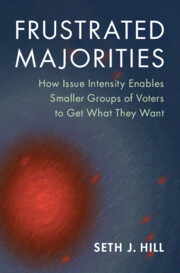Book contents
- Frontmatter
- Contents
- Figures
- Tables
- Theorems
- Acknowledgments
- Part I Frustrated Majorities, Issue Intensity, and Political Action
- Part II Argument: an Intensity Theory of Electoral Competition
- 3 Sketching a Theory of Intensity and Electoral Competition
- 4 Theory and Model Results: Issue Intensity, Costly Action, and Minority Representation
- 5 Model Extensions: Varying Size of the Minority, the Free-Rider Problem, and Social Welfare
- Part III Evidence: Empirical Patterns and Intensity Theory
- Part IV Conclusions
- Part V Appendices
- Bibliography
- Index
- Other books in the series
3 - Sketching a Theory of Intensity and Electoral Competition
from Part II - Argument: an Intensity Theory of Electoral Competition
Published online by Cambridge University Press: 15 September 2022
- Frontmatter
- Contents
- Figures
- Tables
- Theorems
- Acknowledgments
- Part I Frustrated Majorities, Issue Intensity, and Political Action
- Part II Argument: an Intensity Theory of Electoral Competition
- 3 Sketching a Theory of Intensity and Electoral Competition
- 4 Theory and Model Results: Issue Intensity, Costly Action, and Minority Representation
- 5 Model Extensions: Varying Size of the Minority, the Free-Rider Problem, and Social Welfare
- Part III Evidence: Empirical Patterns and Intensity Theory
- Part IV Conclusions
- Part V Appendices
- Bibliography
- Index
- Other books in the series
Summary
In this chapter I walk through the how and why of a theory of issue intensity and electoral competition and build the basics of the mathematical model used to explore intensity theory. I lay out six foundational assumptions of the model drawn from existing theories of elections in political science or political economy. The assumptions rule out current explanations for frustrated majorities so that I can show that the combination of issue intensity and electoral competition alone can cause frustrated majorities. I show how costly political action becomes an important part of the story when candidates cannot perfectly observe the issue intensity of voters. I then present a simple mathematical model with numerical examples to provide intuition for analysis in subsequent chapters.
Keywords
- Type
- Chapter
- Information
- Frustrated MajoritiesHow Issue Intensity Enables Smaller Groups of Voters to Get What They Want, pp. 47 - 67Publisher: Cambridge University PressPrint publication year: 2022

